What is the name of a red orange?
Bloody, red, pigmented, Sicilian orange, orange - all these are names of citrus with ruby or orange-red pulp. Tarocco, Moro and Sanguinello varieties are popular in Europe and the USA. Unusual fruits are loved for their bright aroma, juiciness, sweet taste with a slight sourness. Let's look at what kinds of blood oranges there are, what they are called, and where they are grown.
Why do oranges have red veins inside?
We are used to seeing oranges on store shelves of a standard orange color with bright yellow or orange pulp, but sometimes pulp with red veins is hidden under the peel.
This is not a product of genetic engineering, but just a variety of orange. In our area, such fruits are rare, so they raise bewilderment and a lot of questions.
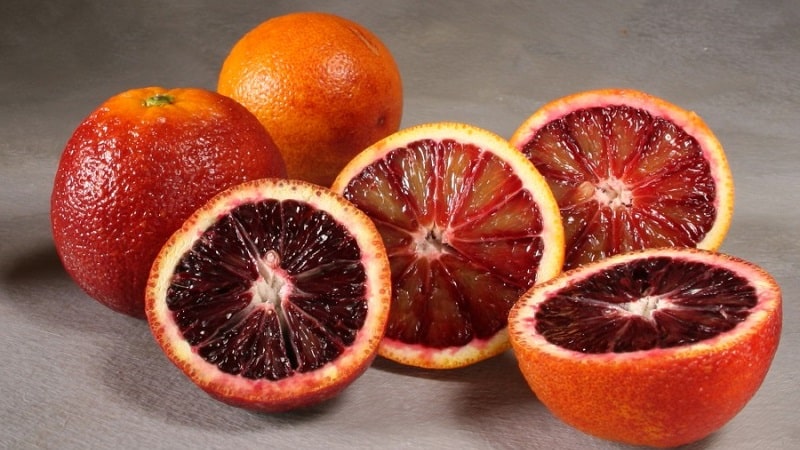
The red color of the pulp appears due to anthocyanins, pigments with antioxidant properties., which are found in most red fruits and berries, but rarely in citrus fruits. It is for their anthocyanins that citrus fruits are highly valued in the world. The color intensity depends on the lighting, the air temperature in the growing region and the variety.
Reference. Anthocyanins slow down the aging process in the body and protect cells from damage due to oxidation.
The main condition for the appearance of anthocyanins is low temperature at night, contrasting with daytime. Such sharp fluctuations are typical for the homeland of ruby oranges - Sicily. Pigments accumulate at the time of ovary formation.In autumn and winter the process develops more actively. The fruits turn red even after picking, especially when stored in a dark room at low temperatures.
Interesting things on the site:
What is the red inside of an orange called?
Red, or pink, citrus appeared as a result of a natural mutation of an ordinary orange., which was formed due to the cross-pollination of mandarin and pomelo. Such mutations were first discovered on the island of Sicily. Hence the second common name for the fruit is Sicilian. The variety is known as blood orange and kinglet.
Reference. 35 million orange trees are cultivated in Spain, but Brazil holds the lead, where about 18 tons of fruit are harvested annually.
Historical sources contain information that oranges appeared in Europe from China. In the same time, there is an ancient Greek myth about the Hesperides, who grew golden apples of immortality in the garden. The Greeks will say with full confidence that they were talking about oranges, because in Ancient Greece citrus fruits were called hesperidia, and a little later - portocales for their orange peel (translated from Greek, “orange” sounds like “portocales”).
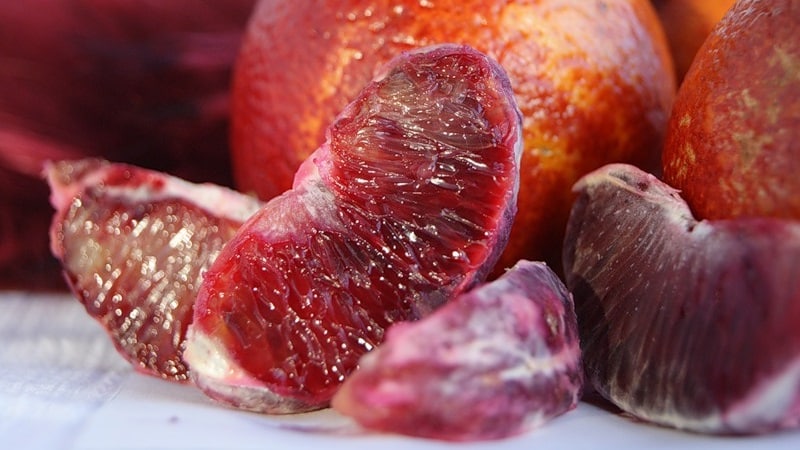
Where do blood oranges grow?
Plantations of the crop are located in Spain, China, Morocco, USA (California and Florida), Greece, Italy.
They say that the most delicious kings are grown in Malta, but Sicilian soil is the most favorable for the cultivation of this variety of citrus fruits. On the island is the Mount Etna volcano, which periodically ejects ash rich in minerals.Although Etna is an active volcano, its slopes are densely populated and locals consider the land extremely fertile.
Blood oranges growing in Albania, Turkey, Georgia. In Russia they are grown in greenhouses and greenhouses.
What do they taste like
Bloody Citrus famous for their tender, very juicy and sweet pulp with a slight sourness. The taste is dominated by orange notes and raspberry flavors.
Read also:
The benefits and harms of orange peels
Popular varieties
There are 3 varieties on sale: Tarocco, Moro, Sanguinello. Each of them is unique.
Tarocco comes from Italy. It is believed that the name comes from the cry of an astonished farmer who first discovered this variety. Tarocco is very popular in Italy.
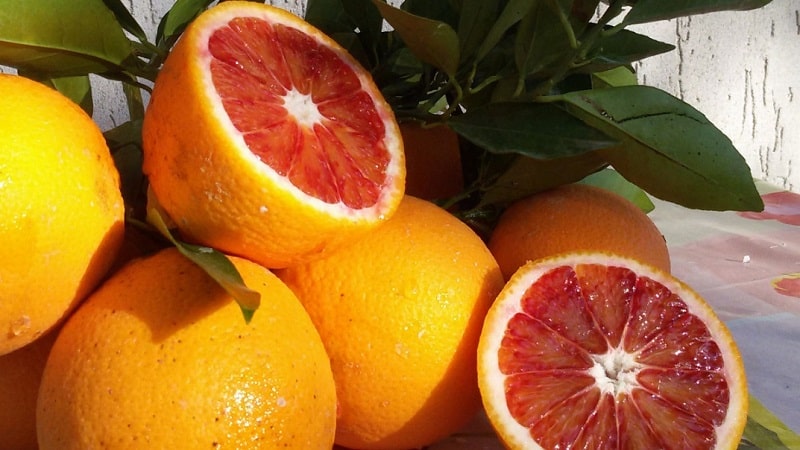
The fruit has a thin orange skin with a faint red tone. This is the sweetest variety of king, and the pulp contains a minimum number of seeds. The fruits are round and medium. The pulp is juicy, reddish-orange. The taste is sweet and sour, the aroma is berry. The historical homeland of the variety is the foot of the Etna volcano. The region's fertile soil gives Tarocco its unique flavor. The fruit contains more ascorbic acid than other citrus fruits.
Reference. Biologists suggest that it occurred as a result of a mutation of Sanguinello, otherwise it is called “half-breed” due to the fact that the flesh does not have such pronounced red pigmentation as that of Sanguinello and Moro.
Sanguinello - Spanish ancient variety of kinglet. The fruits are elongated, the peel is orange, with red splashes. The variety is late-ripening, harvested at the end of March.The flesh color ranges from dark orange, with bright red streaks, to purple-black, and the fruit contains few seeds.
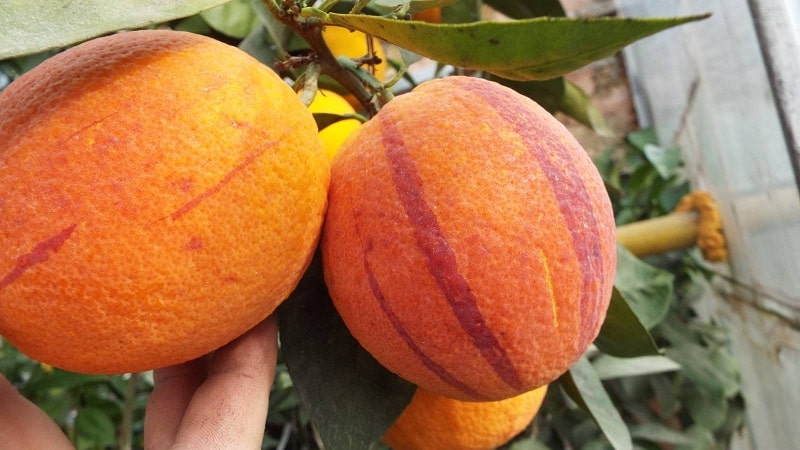
Moro is a new variety that appeared in the 19th century on the island. Sicily. The fruit is oval, the peel is orange, with a wine blush. The diameter of citrus fruits is 5–8 cm, weight is 150–180 g. The pulp is juicy burgundy-red, almost without seeds, and if you come across them, they are small and soft. The taste is sweet, rich, with raspberry notes, and the aroma is strong and recognizable.
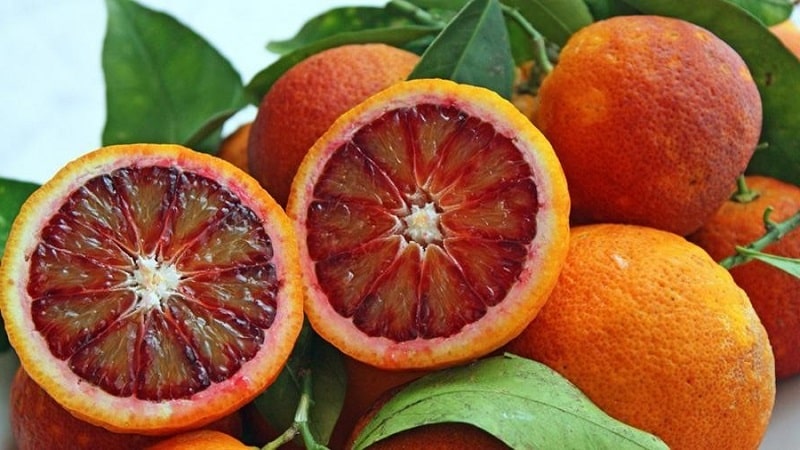
Conclusion
Oranges with red flesh are very popular in Europe and the USA, and until recently, Russian shelves were mostly stocked with the usual orange citrus fruits. In recent years, the situation has changed, and kings - oranges with ruby, orange-red flesh - have increasingly been brought to our country. They are much sweeter and more aromatic than the orange ones, with raspberry notes in the taste.
The most famous varieties are Moro, Tarocco and Sanguinello, which vary slightly in size, shape and color of the flesh. Sanguinello fruits have the most intense color. Tarocco citruses contain a lot of vitamin C, and Moro oranges are the smallest and sweetest.